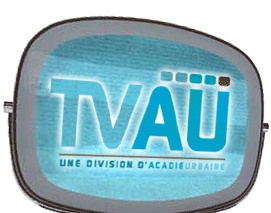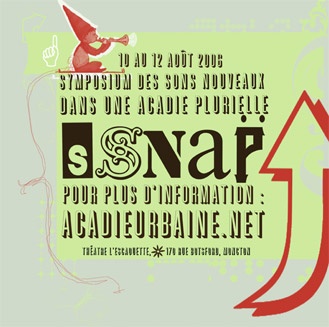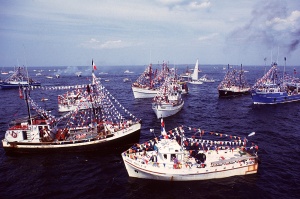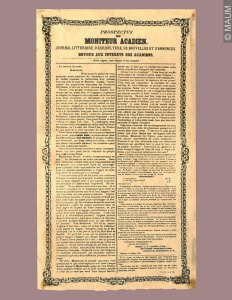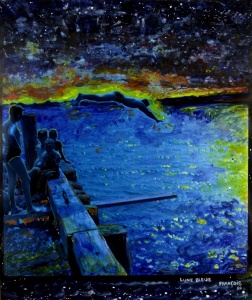Acadie Urbaine: A New Virtual Web Space for Acadian Heritage
par Robineau, Anne
The website Acadie Urbaine is a new virtual space for contemporary Acadian culture. Not only is it a forum for ideas and creativity, it also has become the symbolic cultural anchor of young artists and intellectuals in modern Acadia who are ever open to the world. This innovative contribution to Acadian cultural heritage is evidence of the vitality of the rising generation, which is progressively liberating itself from a history marked by the Deportation and their predecessor's nationalist tendencies. As a tool that transcends borders, this website is also representative of a new kind relationship that is developing between the Acadian people and their territory: one of an Acadian culture founded on networking.
Article disponible en français : Acadie urbaine: nouvel espace virtuel du patrimoine acadien
The Virtual World of Acadie Urbaine: A Substitute for Folklore
The website Acadie Urbaine resulted from the need to create a cultural forum adapted to the reality of Acadia today. This reality was marked by the development of an urban culture that seeks to reinforce the strength of local culture and encourages openness to the world. Various media, new technology and other recent phenomena, such as the globalization of the economy and culture are all factors that favour the emergence of this new mentality of a generation that desires change. Acadie Urbaine is a website that attempts to gather together all those who identify with the Acadian culture, as well as those who desire to see more contemporary ideas and customs flourish. This virtual world offers another way of looking at Acadian society that is less conventional than the point of view offered by traditional folklore-a perspective that has long been the foundation of Acadian heritage.
Created in 2004 in Moncton by Pat Furlong and a group of artists from Acadie Urbaine, this virtual space hosts a radio station, discussion forums, a digital art gallery, and a television station (TVAU), among other things. Most of the content is created and maintained by members of the site. Various sections are still under construction (e.g., the section on Acadian history and a database of contemporary Acadian artists). However, the site is already an innovative discussion forum for exchanging ideas on what truly makes up Acadian culture and identity. The discussion forum is both a place for informal debate, as well as a place where a more profound introspection on the growing need to contribute to an "inclusive Acadia" can take place. From this point of view, criticism of the historical foundations of Acadia and of its various institutions is considered to be an important step to creating this new Acadia. And so, the criticism offered by various artists is described as being a means by which the rising generation of young artists and intellectuals can fully come into its own-as it asserts the contemporary values that it so cherishes. Memorable texts written by those that embody these social changes can be read on the website. Texts such as those of the poet, Gerald Leblanc, who considered by many artists to be the "father" of contemporary artistic ideology in Acadia.
In addition to the content, many artistic events are posted on Acadie Urbaine, such as the annual multidisciplinary artistic event, Symposium des Sons Nouveaux dans une Acadie Plurielle [Symposium for Fresh Voices in a Culturally Diverse Acadia] (SSNAP), which exhibits recent artistic creations to the Acadian public. In addition, the television station TVAU uploads short reports and documentaries on various performances, shows and festivals on Acadian culture. Some examples are: the Festival du Cinéma Francophone en Acadie [Acadian French-Language Film Festival], the Frye Festival, a literature festival, and the launch of the DVD Acadieman (an Acadian superhero). Acadie Urbaine also has a collection of music available online through Acadieurbaine.net. Via these new media that are intended to create new social ties, the Acadie Urbaine virtual space enables Acadians to exchange ideas and discuss anew just what it means to be Acadian today. Networking and creating cultural ties is a rather good way for a generation to build a common heritage-but developing such ties and negotiating cultural identity is nothing new-for such discussions had already started to take place a long time ago in other ways. As is the case now, it was not done a without a certain degree of turbulence.
Culture and Territory: Building Acadian Heritage
Acadie Urbaine builds on a people's longing to distance themselves from a traditional vision of culture. However, it is also paradoxically due to the Acadian people's desire to reunite around their language, their faith, and their traditions that their unique culture came to exist. Building Acadian heritage is linked with the early attempts to define Acadian culture without having clear territorial boundaries. After the Deportation of Acadians and their subsequent gradual return, the lengthy task of establishing and writing down their history was carried out. The endeavour involved discussing and promoting divergent interpretations of their history. Different points of view on the Acadian people's relationship with land and the status of their community were at the very heart of the discussions. Even to this day, many definitions coexist, ranging from an Acadia which takes in only the Atlantic Provinces to another more encompassing one that takes in groups of Acadians spread across Maritimes, as well as many other communities (in particular, those residing in Quebec and Louisiana). Despite these differences, it is certain that Acadia exists-at least culturally and symbolically-and it truly draws on a collective feeling of belonging to create a sense of cultural unity.
The Acadian people's sense of belonging developed over time, not only due to the endeavours of the general population, but also to the efforts of the higher ranking clergy and the upper class who were desirous of affirming their political, economic and religious presence in society. During the second half of the 19th century, the regions where they had settled began to feel the effect of their activities. From this period on, the Acadian community began to systematically build its own educational institutions and news medias, such as the well-known Moniteur Acadien. This led to development of a strong cultural identity founded on the notion of a diaspora community with a unique history.
Although today the Acadian concept of cultural identity has been superimposed by other, more recent cultural values, it originally started being scrutinized during the 1960's. As in the rest of French Canada, this period was marked by efforts to modernize institutions and politicize the various social debates. At the centre of the transformations society was undergoing at the time was the establishment of a welfare state. The political activism that accompanied the upheavals provoked a change in how the Acadian territory was referred to. The place that Acadians occupied in society (and in the world in general) went from being a physical or symbolic reference to defining a more legal conception of what is Acadian. In fact, Acadians now have legal status in their respective provinces and can defend their rights. New Brunswick, which has the highest concentration of Acadians, has made considerable progress. A few examples of these changes are the province's current official bilingual status and the founding of the Université de Moncton, the first French-speaking university outside Quebec. Thanks to these successful social and political endeavours, the development of the Acadian culture can now move forward. By cultivating pride and a sense of belonging to their culture, an entire generation of Acadians have been able to contribute to building a common heritage. This heritage, which has its earliest roots in history and which was once firmly grounded in traditional folklore has now started opening up to accepting more contemporary and critical perspectives of its identity. It is this new direction that inspired the creation of Acadie Urbaine. However, in order to understand this new turn of events, we must first go back to a previous period of Acadian history-to a time when symbols of Acadian culture were being reinvented and then contextualised and presented to the people.
Acadian Culture and Identity: Cultural Symbols for Promoting History
The most well known cultural symbols of Acadian Heritage are without a doubt its three-colour flag (blue, white, red) complete with golden star, its national celebration on the 15th of August and its national anthem taken from the hymn l'Ave Maris Stella. These symbols from the end of the 19th century make reference to the Acadians' French origins. They also firmly ground their identity in their Catholic faith and in the Maritime region of Canada.
A more recent symbol, the Grand Tinatamarre, brings Acadians out during their national celebration on the 15th of August. Since 1992, on this day, Acadians have been invited to parade in the streets of their communities with colourful objects and decorated instruments-one can say it's a very festive occasion. On the day of the festivities, hundreds of Acadian flags can be seen demonstrating the pride the people take in their identity.
This brief return to traditional roots continues with other cultural activities. We often find themes linked to Acadian history in the arts, literature and music created in the region. The folklore has also become an attraction for thousands of tourists each year. Le Pays de la Sagouine [Sagouine's Acadia] and the Village Historique Acadien [Acadian Historical Village] are two of the main attractions where the history of Acadian people is on display for all comers. Visitors can learn about this people's way of life throughout the centuries-including the Deportation.
It should not, however, be assumed that Acadian culture essentially consists of folklore and traditions. A new generation of artists and intellectuals contribute to yet another offshoot of Acadian heritage; for they propose an alternative to folklore without systematically opposing it. Although this generation is still inspired by folklore, they are also able to criticize it. There are even examples of certain parodies of various folkloric traditions. Such is the case of Acadieman, an Acadian super "anti-hero" who works in a call centre, speaks in Chiac [a local dialect] while he watches American television. The role of Acadie Urbain is at the centre of these contemporary views of Acadia-all which seek to build a creative online network where innovative ideas converge in a place that is open to criticism, debate and introspection. This piece of Acadian heritage, which has been brought to life by its dynamic young creators, has not yet finished offering surprising and astonishing, innovative turns of creativity. As it blazes new trails of self-discovery, it is becoming ever more firmly established as a permanent part of Acadian society.
Anne Robineau
Assistant Researcher
Canadian Institute for Research on Linguistic Minorities
BIBLIOGRAPHY
Basque, Maurice, L'Acadie de l'Atlantique, Moncton, CEA, 1999.
Belliveau, Joel et Frédéric Boily, « Deux révolutions tranquilles? Transformations politiques et sociales au Québec et au Nouveau-Brunswick (1960-1967) », Recherches sociographiques, n° 1, vol. XLVI, p. 11-34.
Fourmentraux, Jean-Paul, Art et Internet. Les nouvelles figures de la création, Paris, CNRS-Éditions, 2005.
Landry, Nicolas et Nicole Lang, Histoire de l'Acadie, Sillery, Septentrion, 2001.
Pâquet, Martin et Stéphane Savard (dir.), Balises et références. Acadies, francophonies, Québec, PUL, 2007.
Massicotte, Julien, « Le territoire acadien. Contextes et perceptions » dans Pâquet, Martin et Stéphane Savard (dir.), Balises et références. Acadies, francophonies, Québec, PUL, 2007, p. 79-103.
Thériault, Joseph Yvon, Faire société. Société et espaces francophones, Ottawa, Prise de Parole, 2007.
Additional DocumentsSome documents require an additional plugin to be consulted
Documents sonores
-
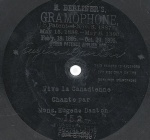 À Moncton
Interpreter : Marie-Jo Thério.
Writer : Marie-Jo Thério.
Album : Comme de la musique, 1995.
À Moncton
Interpreter : Marie-Jo Thério.
Writer : Marie-Jo Thério.
Album : Comme de la musique, 1995.
-
 C'est ça mon Acadie
Interpreter : Cayouche.
Writer : Réginald Charles Gagnon.
Album : Roule, roule, 1999.
C'est ça mon Acadie
Interpreter : Cayouche.
Writer : Réginald Charles Gagnon.
Album : Roule, roule, 1999.
-
 Paquetville
Interpreter : Édith Butler.
Writer : Lise Aubut, Édith Butler.
Album : À l’année longue, 1995 (1980).
Paquetville
Interpreter : Édith Butler.
Writer : Lise Aubut, Édith Butler.
Album : À l’année longue, 1995 (1980).
Document PDF
Hyperliens
- Acadie urbaine
- Association internationale d’études acadiennes
- Musée acadien
- Site sur la francophonie canadienne, section «Acadie»
- cyberacadie.com
- Village historique acadien
- Pays de la Sagouine
- Festival du cinéma francophone en Acadie
- Festival Frye
- Acadieman
- Moniteur Acadien
- Université de Moncton
- Encyclopédie: Tintamarre, une nouvelle « tradition » en Acadie


